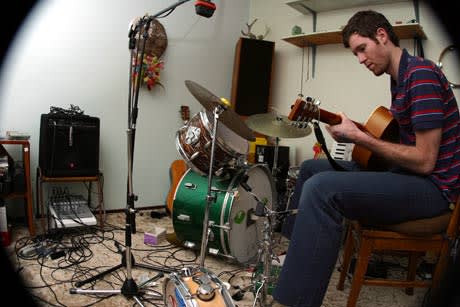Though his aesthetic is quite different, Chad VanGaalen comes across as Jim Guthrie's younger Calgary cousin. VanGaalen was also introduced to a four-track at an impressionable age, and spent years writing and recording an impressive body of work, giving copies away to friends in handmade cases. The release of his first widely available recording, Infiniheart, also gives you the sense that his days toiling in obscurity are numbered. The 19 sparkling tracks on the album represent, for the most part, work recorded since 2000 (though he has self-released two CDs of new songs since this was compiled). Infiniheart can quickly induce a dreamlike state even if you've had a few coffees, but it's more akin to lucid dreaming: the sense of being captive in another world, but with the freedom to choose what you experience. There are enough pop signposts to guide the less adventurous through the moody sound experiments and on-the-fly recordings, and lines like "sometimes the radio plays to no one" linger in the sonic ether long after the CD ends. Not unlike the prairie itself, the beauty of this recording resides in both its spaciousness and apparent desolation. VanGaalen's fragile voice hovers on the edge of all this, and comparisons to Neil Young are inevitable. But with his experimental tendencies, he's coming from a very different place. He's not to be written off as another mopey bedroom genius either other projects include a collaboration with fellow Calgarian Eric Hamelin, and Boston-based Noel Webber and none other than Mary Timony.
Were you familiar with other artists who'd done home recordings? Not really. I think I kept myself out of the whole loop. But I was fascinated with [four-tracking] so I made myself into a hermit. I wasn't listening to what was going on, which was good and bad. I developed a language on my own, with the instruments, which I couldn't really share.
What are the differences between collaborative projects, and working by yourself? By myself feels really, really easy. I know how everything's gonna sound. It's easy for me to mic a room and work with the tools I have fairly successfully. I know how hard to hit the drums. Recording with other people, it's hard for me, because they're not really in tune with the instruments in the same way.
So how do you translate these songs to a live setting? I've been playing one-man shows and it translates well because the songs are fairly simple. When I play with other people, I pretty much let them do whatever they want to, which includes writing their own lyrics over mine. I'm trying to put together a rock and roll orchestra right now, where everybody's pretty open to improvisation, within a pop, sort of punk, framework. Keeping it pretty loose. With costumes and stuff.
(Catch and Release)Were you familiar with other artists who'd done home recordings? Not really. I think I kept myself out of the whole loop. But I was fascinated with [four-tracking] so I made myself into a hermit. I wasn't listening to what was going on, which was good and bad. I developed a language on my own, with the instruments, which I couldn't really share.
What are the differences between collaborative projects, and working by yourself? By myself feels really, really easy. I know how everything's gonna sound. It's easy for me to mic a room and work with the tools I have fairly successfully. I know how hard to hit the drums. Recording with other people, it's hard for me, because they're not really in tune with the instruments in the same way.
So how do you translate these songs to a live setting? I've been playing one-man shows and it translates well because the songs are fairly simple. When I play with other people, I pretty much let them do whatever they want to, which includes writing their own lyrics over mine. I'm trying to put together a rock and roll orchestra right now, where everybody's pretty open to improvisation, within a pop, sort of punk, framework. Keeping it pretty loose. With costumes and stuff.
